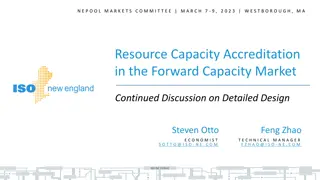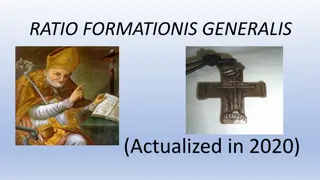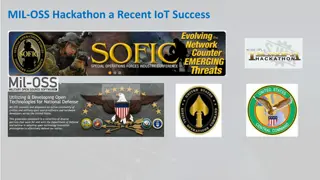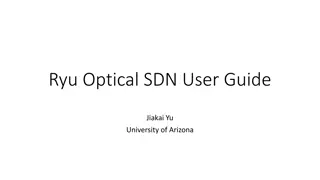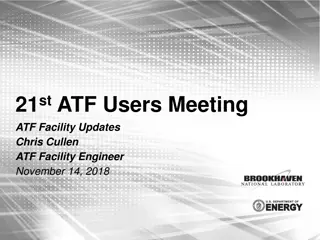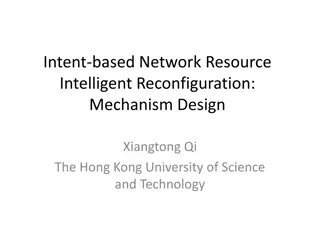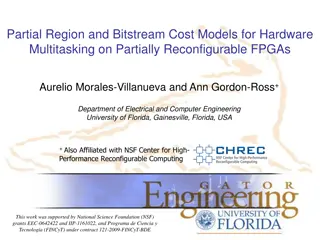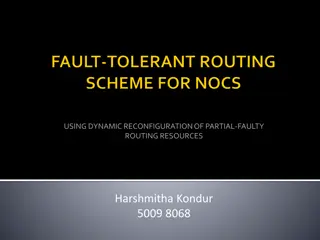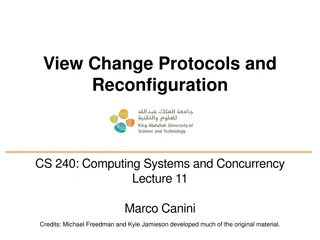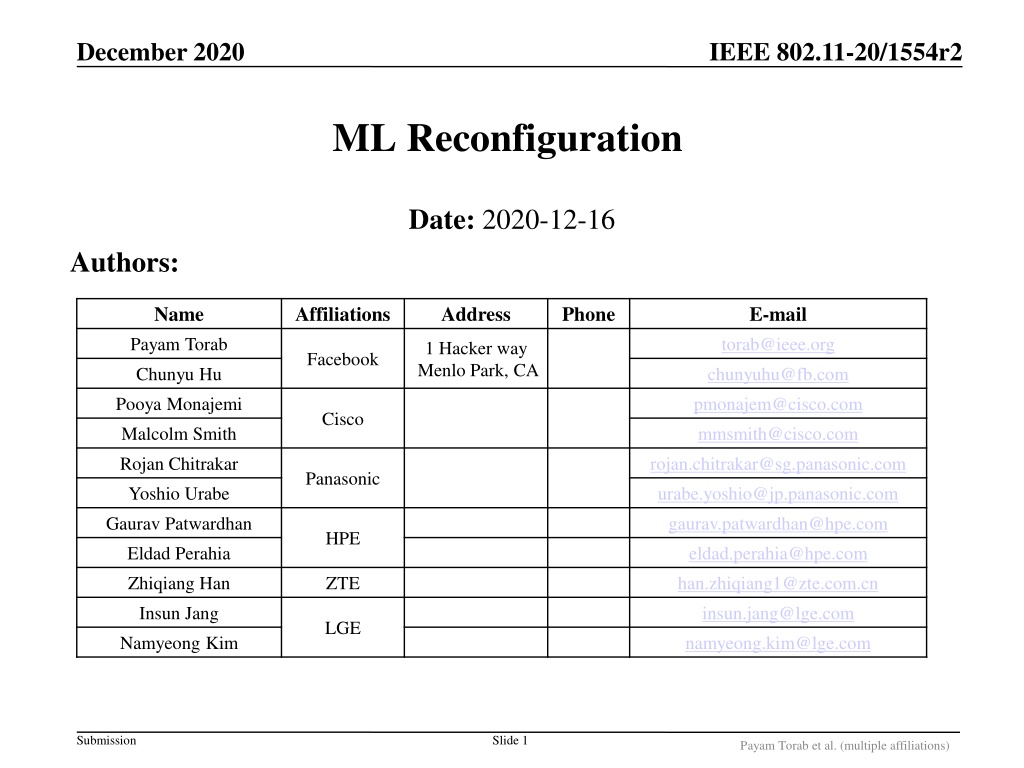
IEEE 802.11-20/1554r2 December 2020 ML Reconfiguration
Explore the IEEE 802.11-20/1554r2 document discussing Multi-Link (ML) reconfiguration post-association, improving robustness and management in wireless networks. Touching on scenarios, procedures, and benefits of altering STA entity mappings within Multi-Link Devices (MLDs).
Download Presentation

Please find below an Image/Link to download the presentation.
The content on the website is provided AS IS for your information and personal use only. It may not be sold, licensed, or shared on other websites without obtaining consent from the author. If you encounter any issues during the download, it is possible that the publisher has removed the file from their server.
You are allowed to download the files provided on this website for personal or commercial use, subject to the condition that they are used lawfully. All files are the property of their respective owners.
The content on the website is provided AS IS for your information and personal use only. It may not be sold, licensed, or shared on other websites without obtaining consent from the author.
E N D
Presentation Transcript
IEEE 802.11-20/1554r2 December 2020 ML Reconfiguration Date: 2020-12-16 Authors: Name Payam Torab Chunyu Hu Pooya Monajemi Malcolm Smith Rojan Chitrakar Yoshio Urabe Gaurav Patwardhan Eldad Perahia Zhiqiang Han Insun Jang Namyeong Kim Affiliations Address Phone E-mail torab@ieee.org chunyuhu@fb.com pmonajem@cisco.com mmsmith@cisco.com rojan.chitrakar@sg.panasonic.com urabe.yoshio@jp.panasonic.com gaurav.patwardhan@hpe.com eldad.perahia@hpe.com han.zhiqiang1@zte.com.cn insun.jang@lge.com namyeong.kim@lge.com 1 Hacker way Menlo Park, CA Facebook Cisco Panasonic HPE ZTE LGE Submission Slide 1 Payam Torab et al. (multiple affiliations)
IEEE 802.11-20/1554r2 December 2020 Introduction Multi-link operation (MLO) is an established feature of 11be o STA* entities within Multi Link Devices (MLDs) forming connections referred to as links o A link is a pairing of one AP STA* of an AP MLD and one non-AP STA* of an associated non-AP MLD We refer to the mapping between AP and non-AP STA* entities of two associated MLDs as the Multi-Link (ML) Configuration There are MLO scenarios that require changing the ML configuration established at association time see [20/0810] for discussion o Radio | processing core becoming available/unavailable (device centric) o Reachability | range changes (environment, mobility) Furthermore, details of deciding the ML configuration at association time are not clear *We prefer a different name for these entities in the the 802.11 architecture (e.g., endpoints ), but have kept the term STA to stay consistent with contributions to this point. Submission Slide 2 Payam Torab et al. (multiple affiliations)
IEEE 802.11-20/1554r2 December 2020 Introduction We discuss ML Reconfiguration, an umbrella term for a set of procedures (information dissemination, signaling) aimed at changing the mapping of STA entities within MLDs (the ML configuration ) post association o Multiple links (paths) improves robustness of both data and management planes Robust management: Making changes to configuration without having to disassociate Change to the mapping can include changes in number of links ML reconfiguration example o Note: Some changes to ML configuration may require multiple steps (e.g., adding a new AP to an AP MLD, deleting a link terminating on an AP within the AP MLD, adding a new link terminating on a different AP within the AP MLD ) STA 1 AP 1 STA 1 AP 1 STA 2 AP 2 STA 2 AP 2 STA 3 STA 3 AP 3 AP 3 ML Reconfiguration AP 4 AP 4 AP MLD Associated Non-AP MLD AP MLD Associated Non-AP MLD Submission Slide 3 Payam Torab et al. (multiple affiliations)
IEEE 802.11-20/1554r2 December 2020 Why ML reconfiguration Some MLO scenarios require changing the ML configuration o Radio becoming available/unavailable post association (changes in device) Maintenance, hardware additions, hardware failure, upgrades ... o New reachability/range with mobility (changes in environment) o New traffic conditions (static/permanent increase/decrease in traffic) o See [20/0810] for discussion Changing ML configuration does not require disassociation o As long as there are unaffected links through the process to carry out the signaling Submission Slide 4 Payam Torab et al. (multiple affiliations)
IEEE 802.11-20/1554r2 December 2020 More on ML configuration (1) Deciding the ML configuration at association time Beacon, Probe Response Probe Request, Association Request References [20/0389] [20/0390] [20/0865] References [20/0389] [20/0390] [20/0741] [20/1274] [20/1592] STA1 AP1 AP MLD Non-AP MLD- AP2 AP3 AP4 STA2 STA3 Elements: RNR, ML AP STA capabilities Elements: ML Non-AP STA capabilities ML configuration (= mapping between AP and non-AP STAs) decided by non-AP MLD 2.4 GHz channel STA1 AP1 AP MLD Non-AP MLD- AP2 AP3 AP4 STA2 STA3 6 GHz channel Non-AP MLD decides the STAs and mapping to APs, based on many factors including capabilities (e.g., channels, number of spatial streams) Optional subelements Element ID (=255) Element ID Extension Multi-Link Control Per-STA Profile y (if present) ML element in Association Request declares a mapping by indicating the Link ID (better name is AP ID) corresponding to each non-AP STA [20/1274] Length Field 1 Field k Per-STA Profile x ... Subelement ID (=0) Length Data Complete Profile (=1) The choice (including number) of non-AP STAs to connect to AP STAs and the mapping to AP STAs belongs to non-AP MLD Link ID ... That is, non-AP MLD decides the number and endpoints of the links, which is accepted or rejected by the AP MLD Non-Inheritance element (if present) Per-STA Control field ... Element n+1... ... ... Element 2 Element n Element L Element Y Fixed order for certain Fields / IEs (1 or more) Element order as defined in Beacon frame or Association Request frame Last element Submission Slide 5 Payam Torab et al. (multiple affiliations)
IEEE 802.11-20/1554r2 December 2020 More on ML configuration (2) Deciding the ML configuration at association time Desired ML configuration (mapping between non-AP and AP STAs of MLDs) is specified through the ML IE in Association Request AP MLD can reject a requested ML configuration for a variety of reasons o Association Response must include proper error code and possibly a recommended ML reconfiguration in case of rejection Submission Slide 6 Payam Torab et al. (multiple affiliations)
IEEE 802.11-20/1554r2 December 2020 ML reconfiguration scenarios (1) Requiring a change in the AP endpoint of a link Scenario: AP MLD associated with 3 MLDs, decides to move the 5 GHz operation of MLD2 and MLD3 to 6 GHz STA1 Non-AP MLD with 3 STAs (no change in configuration) 2.4 GHz Non-AP MLD1- STA2 AP1 5 GHz STA3 AP MLD AP2 Move 5 GHz endpoint Non-AP MLD with 2 STAs (connected to 2 APs of the AP MLD; this MLD needs ML reconfiguration) AP3 STA1 ... to 6 GHz Non-AP MLD2- STA2 MLD1 (3 STAs) on 2.4, 5 and 6 GHz MLD2 (2 STAs) on 2.4 and 5 GHz MLD3 (2 STAs) using 2.4, 5 and 6 GHz 6 GHz 5 GHz congestion or link loss, or just traffic engineering Non-AP MLD with 3 STAs (connected to 3 APs of the AP MLD; this MLD can simply disable the 5 GHz link) STA1 Non-AP MLD3- STA2 MLD1 (3 STAs) on 2.4, 5 and 6 GHz MLD2 (2 STAs) on 2.4 and 6 GHz MLD3 (2 STAs) using 2.4 and 6 GHz STA3 ML reconfiguration to change the AP endpoint of a link; common scenarios o Fewer non-AP STAs than AP STAs within associated MLDs (no 1:1 mapping), or o AP STAs tied to certain bands/channels (switching constraints, or radio in use) Potential steps (separate, or possibly combined) o (Non-AP MLD2) remove the STA2 AP2 link o (Non-AP MLD2) add the STA2 AP3 link Submission Slide 7 Payam Torab et al. (multiple affiliations)
IEEE 802.11-20/1554r2 December 2020 ML reconfiguration scenarios (2) Requiring a change in the non-AP endpoint of a link Scenario: AP MLD associated with 3 MLDs, decides to move the 5 GHz operation of all MLDs to 6 GHz STA1 Non-AP MLD with 2 STAs (one of the STAs performs a channel switch from 5 to 6GHz) 2.4 GHz Non-AP MLD1- STA2 AP1 AP2 switching from 5 GHz to 6 GHz; needs to connect to different non-AP STAs affiliated with non-AP MLDs Channel switch from 5 to 6 GHz AP MLD AP2 5 GHz switching to 6 GHz 5 GHz Non-AP MLD with 3 STAs (STA2: Only 5 GHz capable, STA3: Only 6 GHz capable, new link on a new STA set up) STA1 Move 5 GHz endpoint Non-AP MLD2- STA2 MLD1 (2 STAs) on 2.4 and 5 GHz MLD2 (3 STAs) on 2.4 and 5 GHz MLD3 (2 STAs) on 2.4 and 5 GHz STA3 ... to 6 GHz 6 GHz 5 GHz congestion or link loss, or just traffic engineering Non-AP MLD with 2 STAs (one of the STAs performs a channel switch from 5 to 6GHz) STA1 Non-AP MLD3- STA2 MLD1 (2 STAs) on 2.4 and 6 GHz MLD2 (3 STAs) on 2.4 and 6 GHz (through a new STA) MLD3 (2 STAs) on 2.4 and 6 GHz Channel switch from 5 to 6 GHz ML reconfiguration to change the non-AP endpoint of a link; common scenarios o Fewer AP STAs than non-AP STAs within associated MLDs (no 1:1 mapping) o Non-AP STAs within an MLD tied to certain bands/channels (switching constraints) Potential steps (some may be optional) o (AP MLD) request MLD2 to remove STA2 AP2 link o (Non-AP MLD2) remove STA2 AP2 link (5 GHz) o (AP MLD) switch AP2 channel from 5 GHz to 6 GHz o (Non-AP MLD2) add STA3 AP2 link (6 GHz) Submission Slide 8 Payam Torab et al. (multiple affiliations)
IEEE 802.11-20/1554r2 December 2020 ML reconfiguration scenarios (3) Other scenarios (similar in nature) Adding a link o Traffic load increase o Channel condition (range, reachability..) changes o New application starts to run, requiring new radio purposed for the type of application, e.g., activating a new 6 GHz radio in response to VR application request Removing a link o Operating on all available links may not always be the best option due to: Efficiency, power save Less management overhead Sticking with the dominant traffic component (e.g., keeping a TID with 5% of the traffic together with the only other TID carrying 95% of the traffic, in one link) Note: There should be no reason for AP to reject a non-AP request to remove a link See [20/810] (Dynamic Link Set) for more discussion Submission Slide 9 Payam Torab et al. (multiple affiliations)
IEEE 802.11-20/1554r2 December 2020 ML reconfiguration | Summary ML reconfiguration: A set of procedures to change the AP/non-AP STA mapping within the associated MLDs Non-AP MLD AP MLD Non-AP connecting to new AP Reconfiguration components (absent in the current framework early discussion [19/1943], [20/0741]), o Adding | removing an AP (within MLD) o Adding | removing non-AP (within MLD) o Adding | removing a link o Changing AP end or non-AP end of a link Note: Changing one end of the link can be achieved through link removal and addition; listed separately to leave open the possibility of a one-step solution Fewer non-AP STAs than AP STAs within MLDs, or AP STAs having band/channel switching constraints Non-AP MLD AP MLD AP connecting to a new non-AP Fewer affiliated AP STAs than affiliated non-AP STAs, or affiliated non-AP STAs having band/channel switch constraints Non-AP MLD AP MLD Adding | removing a link Reconfiguration initiated by non-AP or AP (details subject of straw polls) New link was not set up at association time (adding a link), or link removed permanently from protocol standpoint Submission Slide 10 Payam Torab et al. (multiple affiliations)
IEEE 802.11-20/1554r2 December 2020 Operations that are not ML reconfiguration TID switch o Change of TID-to-link mapping Non-AP MLD AP MLD TID 1 (split between two links) Channel switch o Change of link-to-channel mapping TID switch Links remain the same, mapping between TIDs and links changes Changes to link power save state Non-AP MLD AP MLD Channel switch None of these operations changes the mapping of AP/non-AP STAs decided at association time No change from MLO perspective; same link operating on a different channel Non-AP MLD AP MLD Changes to link power save or TIDs Links still set up at association time Submission Slide 11 Payam Torab et al. (multiple affiliations)
IEEE 802.11-20/1554r2 December 2020 Discussion (1) Fit into the architecture ML reconfiguration is part of ML management o It complements other ML management functions such as TID-to-link mapping Reconfiguration sets the stable (longer term) link set TID-to-link mapping for more dynamic adjustments over a given link set (still needed) ML reconfiguration is a basic part of the architecture o There are many use cases, but in general it is not even a question of why o Framework should provide mechanisms to add links, remove links, and possibly modify links (the equivalent of removing a link and adding another, but as one operation) post association, without having to disassociate The case of non-AP connecting to a different AP within the MLDs is remotely similar to BTM, but there is really no network wide transition o For example, a BTM-like signaling can be used, but there is no re-association o Assuming same PTK for all ML links, PTK can stay the same, and new GTK set up on new links Submission Slide 12 Payam Torab et al. (multiple affiliations)
IEEE 802.11-20/1554r2 December 2020 Discussion (2) Symmetry, traffic hit ML reconfiguration is generally a symmetric operation o There is little difference between AP and non-AP STAs within two associated MLDs in terms of reasons to initiate a link switch Need to add/remove/replace a link can arise on any side AP or non-AP Reconfiguration does not change the MLD-level network roles Reconfiguration can be initiated by the AP MLD however o Non-AP can trigger the operation, similar to sending a Query frame in BTM Traffic loss during the reconfiguration must be minimized o This is a common goal (with potentially common solutions) for all switching scenarios, TID-level or link-level o Design elements from Fast Session Transfer (FST) can be borrowed Data plane ownership during reconfiguration, making sure MPDUs are received on new link(s) before declaring the operation successful Submission Slide 13 Payam Torab et al. (multiple affiliations)
IEEE 802.11-20/1554r2 December 2020 Discussion (3) Disabled links at association time A non-AP MLD that does not match the AP MLD in terms of number of affiliated STAs can create ghost disabled links at association time o For example, non-AP MLD introducing a STA for each AP of the AP MLD o Some links started in a non-active state - indefinite state of power save, TID-free zone (but presumably still allowing groupcast and management frames?), or other variations This is a scenario-dependent choice at association time, requiring o Additional resources (unique MAC addresses, Link/AP IDs, information blocks ) o Additional MAC features (e.g., power save) Creating these links neither replaces nor is precluded by ML reconfiguration o Not a substitute for general link addition (when new links are unavailable or not set up for any reason at association time), link removal (absent from all subsequent signaling), or modifying the link endpoints post association o In some cases, these do not even look similar, e.g., fewer AP STAs than non-AP STAs of different capabilities (see reconfiguration scenario #2) o Matter of operation vs. configuration Slide 14 Submission Payam Torab et al. (multiple affiliations)
IEEE 802.11-20/1554r2 December 2020 Discussion (4) State preservation across ML reconfiguration MLD-level states/parameters preserved across ML reconfiguration o BlockAck operation, TIDs (TSs, TCs) o Security (authentication, possibly PTK) Link-level states/parameters initialized for new/modified links o Power save states, TWT sessions o Per-link security attributes (e.g., GTK) ML reconfiguration is generally not a substitute for frequent switching between two or more links (as in enhanced multi-link single radio for example) o Logic should be simple and straightforward; for example, TIDs mapped to links modified during ML reconfiguration (if those links have not been vacated) fall back to to TID-to-any link, until possibly mapped again Fresh new power save state Submission Slide 15 Payam Torab et al. (multiple affiliations)
IEEE 802.11-20/1554r2 December 2020 Straw Poll 1 Link addition/removal initiated by non-AP MLD Do you agree to add to TGbe SFD in R1, a mechanism for a non-AP MLD to add or remove links to an associated AP MLD, subject to the following, o The AP MLD may reject a request to add a link o The AP MLD shall not reject a request to remove a link Note: In case of adding a link, additional AP STAs within the AP MLD can be known prior to association (e.g., ML IE received from AP MLD during discovery), or can be added by the AP MLD post association through updated beacon contents or similar TBD procedure, to be specified as part of defining the mechanism. o Yes o No o Abstain Submission Slide 16 Payam Torab et al. (multiple affiliations)
IEEE 802.11-20/1554r2 December 2020 Straw Poll 2 Link addition at the request of AP MLD Do you agree to add to TGbe SFD in R1, a mechanism for an AP MLD to request an associated non-AP MLD to add a link to the AP MLD, subject to the following, o The non-AP MLD may reject a request to add a link o Yes o No o Abstain Submission Slide 17 Payam Torab et al. (multiple affiliations)
IEEE 802.11-20/1554r2 December 2020 Straw Poll 3 Link removal at the request of AP MLD Do you agree to add to TGbe SFD in R1, a mechanism for an AP MLD to request an associated non-AP MLD to remove a link to the AP MLD, subject to the following, o Request in the form of a recommendation, which the non-AP MLD may reject, or a mandate (notification pointing to a future removal time), which the non-AP MLD cannot reject Note: AP MLD can always stop serving a non-AP MLD on a given MLO link; the mandate (notification pointing to future removal time) case aims to make the process smooth by making the non-AP MLD aware of the impending link removal. This is similar in nature to the Disassociation Imminent indication in the BSS Transition Management Request frame. o Yes o No o Abstain Submission Slide 18 Payam Torab et al. (multiple affiliations)
IEEE 802.11-20/1554r2 December 2020 Straw Poll 4 AP MLD indication of AP STA removal Do you agree to add to TGbe SFD in R1, an announcement-based mechanism for an AP MLD to remove an affiliated AP STA? Note: Announcement mechanism is similar in nature to Extended Channel Switch Announcement, indicating the number of TBTTs left to the moment the affiliated AP STA will become unavailable. The AP MLD should give sufficient advance notice to non-AP MLDs before removing the affiliated AP STA. Definition and mechanisms for sufficient advance notice is TBD. o Yes o No o Abstain Submission Slide 19 Payam Torab et al. (multiple affiliations)
IEEE 802.11-20/1554r2 December 2020 Straw Poll 5 Use of Robust Action frames Do you agree to use Robust Action frames for any post-association link add, remove or modify operation that has been approved in the TGbe SFD in R1? Note: ML reconfiguration operations, subject to approval in TGbe SFD in R1, include link add, remove and modify (i.e., remove plus an add), initiated by non-AP independently, or at the request of AP MLD. o Yes o No o Abstain Submission Slide 20 Payam Torab et al. (multiple affiliations)
IEEE 802.11-20/1554r2 December 2020 Straw Poll 6 Combined/multiple link addition/removal initiated by non-AP MLD Do you agree to add to TGbe SFD in R1, a mechanism for a non-AP MLD to add and remove multiple links to an associated AP MLD through a single request/response exchange? Note 1: Assuming MLD-level association is maintained through one or more links that are not removed throughout the procedure. Note 2: Mechanism details are TBD, but the same mechanisms used by non-AP MLD to add or remove links to the AP MLD post association (e.g., through communicating a modified ML IE) can be extended to signal multiple changes in the ML configuration. o Yes o No o Abstain Submission Slide 21 Payam Torab et al. (multiple affiliations)
IEEE 802.11-20/1554r2 December 2020 References [19/1943] [20/0389] [20/0390] [20/0412] [20/0669] [20/0741] [20/0751] [20/0810] [20/0908] [20/1187] [20/1274] [20/1592] 11-19-1943-09-00be-multi-link-management.pptx 11-20-0389-03-00be-multi-link-discovery-part-1.pptx 11-20-0390-03-00be-multi-link-discovery-part-2.pptx 11-20-0412-01-00be-mlo-link-switching-method.pptx 11-20-0669-00-00be-mld-transition.pptx 11-20-0741-02-00be-indication-of-multi-link-information-follow-up.pptx 11-20-0751-01-00be-multi-link-setup-clarifications.pptx 11-20-0810-01-00be-dynamic-link-set.pptx 11-20-0908-00-00be-multilink-ts-operation.pptx 11-20-1187-00-00be-multilink-setup-discussion.pptx 11-20-1274-09-00be-mac-pdt-mlo-ml-ie-structure.docx 11-20-1592-00-00be-ml-ie-in-authentication-frame.docx Submission Slide 22 Payam Torab et al. (multiple affiliations)
IEEE 802.11-20/1554r2 December 2020 BACKUP SLIDES Submission Slide 23 Payam Torab et al. (multiple affiliations)
IEEE 802.11-20/1554r2 December 2020 Mechanisms with potential design reuse (1) BSS Transition Management (BTM) AP recommending or requiring non-AP to transition to a new AP Query, Request and Response frames Neighbor Report element Submission Slide 24 Payam Torab et al. (multiple affiliations)
IEEE 802.11-20/1554r2 December 2020 Mechanisms with potential design reuse (2) Fast Session Transfer (FST) overview FST is designed to transfer a session (defined as one or more TSs) from one band/channel to another band/channel o TCs should be able to use FST too; TS constraint is probably unnecessary Equivalent of an MLO link is an independent association between the FST endpoints in each band/channel o For example, the endpoints network roles (AP | non-AP relationship) can be different in the new band/channel Operating parameters of each FST association are generally unavailable across BSSs in the FST framework, which means they need to be signaled at transition (through the Multi-band element) o Architecturally, the two endpoints of an FST session do not manage their multiple MAC sublayers through a multiple MAC SME (MM-SME) FST can switch one TID from one BSS to another BSS between two given multi-band devices o Multi-band definitions are general enough to apply to two channels in the same band. Submission Slide 25 Payam Torab et al. (multiple affiliations)
IEEE 802.11-20/1554r2 December 2020 Mechanisms with potential design reuse (3) FST session transfer protocol Session transfer can be initiated by either end (initiator end, the other end called responder) State machine with 4 states (Initial, Setup Completed, Transition Done, and Transition Confirmed), and the following state transition logic, o Initial to Setup Completed : Successful exchange of FST Setup Request and FST Setup Response Action Ack frame; no timeout, retries left to initiator, MAC address-based arbitration between racing requests o Setup Completed to Transition Done : After a STA-based or stream-based (TS- based) countdown to 0; counter initially loaded to LLT 32 s, where link loss timeout (LLT) is specified in the FST Setup Request frame; counter reset to initial value every time an individually addressed frame for the STA or for the specific TS in the STA is received from the peer STA o Transition Done to Transition Confirmed : Successful exchange of FST Ack Request and FST Ack Response (both Action Ack frames) or other MPDUs in the new band/channel Submission Slide 26 Payam Torab et al. (multiple affiliations)

